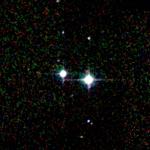摘要
Messier object 40
Messier 40 is a double star with a separation of 53 arc seconds. It was catalogued by Charles Messier in 1764. It is also identified as Winnecke 4 (WNC 4) with position and separation measurements dating back to 1869. There is nothing unusual about the two component stars that make up this object. The two stars are easily visible and resolved in any small telescope. A slow relative motion of the two stars gave the appearance that they were in a slow orbit around each other. In fact their alleged orbital motion was so slow that it was believed that the orbital period was in the range of thousands of years, if indeed this was a true gravitationally bound binary star system.
A fresh investigation of the nature of M40 was undertaken by Richard Nugent in 2002; his results support the hypothesis of an optical double star, i.e. different distances of the two stars: The observed relative proper motion, as measured in separation and position angle, is consistent with a straight, independent motion of the two stars, one crossing between us and the other. From the spectral types provided by Brain Skiff of the Lowell Observatory in 2001, Nugent estimates the absolute magnitudes as Mv=+0.88 and +4.0, masses as 1.1 and 1.2 solar masses for the primary (A) and secondary component (B), and thus derives spectroscopic distances of 1900 +/- 750 and 550 +/- 230 light-years, respectively, the great uncertainties coming from observational inacuracies. This indicates that perhaps the secondary component, B, may be much closer to us than the brighter primary, A.
The numbers imply that if the two components of M40 were a true gravitationally connected binary star system, the period of the orbit would exceed 232,000 years which is unheard of in the binary star community. This orbital period would indicate an actual separation of the pair of some 5,000-7,500 AU's (0.10 light year) which is unrealstic for a binary star system.
Batch
SOURCE: http://www.ipac.caltech.edu/2mass/gallery/messiercat.html
Acknowledgment: Atlas Image [or Atlas Image mosaic] obtained as part of the Two Micron All Sky Survey (2MASS), a joint project of the University of Massachusetts and the Infrared Processing and Analysis Center/California Institute of Technology, funded by the National Aeronautics and Space Administration and the National Science Foundation.
许可协议
| Public domainPublic domainfalsefalse
|

|
This work has been released into the public domain by its copyright holder, Two Micron All Sky Survey (2MASS). This applies worldwide.
在一些国家这可能不合法;如果是这样的话,那么:
Two Micron All Sky Survey (2MASS)无条件地授予任何人以任何目的使用本作品的权利,除非这些条件是法律规定所必需的。
Public domainPublic domainfalsefalse
|
| Public domainPublic domainfalsefalse
|

|
This image is from the Two Micron All Sky Survey (2MASS) project.
At http://www.ipac.caltech.edu/2mass/gallery/aboutimages.html it says:
- "The images and image mosaics in the various Galleries are released into the public domain."
2MASS kindly requests acknowledgement in one of the following forms, the longer of which is preferred.
- Atlas Image [or Atlas Image mosaic] obtained as part of the Two Micron All Sky Survey (2MASS), a joint project of the University of Massachusetts and the Infrared Processing and Analysis Center/California Institute of Technology, funded by the National Aeronautics and Space Administration and the National Science Foundation.
- Atlas Image [or Atlas Image mosaic] courtesy of 2MASS/UMass/IPAC-Caltech/NASA/NSF.
English | español | македонски | português | +/−
|



